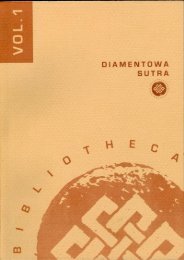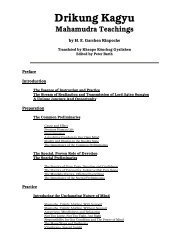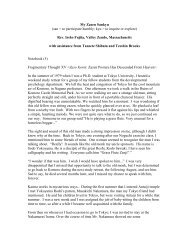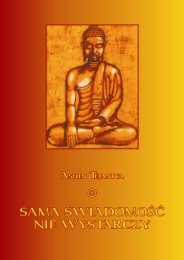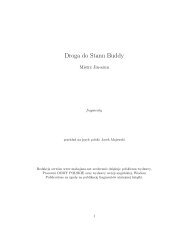3 - Computing in the Humanities and Social Sciences
3 - Computing in the Humanities and Social Sciences
3 - Computing in the Humanities and Social Sciences
You also want an ePaper? Increase the reach of your titles
YUMPU automatically turns print PDFs into web optimized ePapers that Google loves.
particular writ<strong>in</strong>g system of Indian orig<strong>in</strong> used <strong>in</strong> Japan to graphically represent mantric<br />
expressions) on <strong>the</strong> basis of m<strong>in</strong>imal components (calligraphic strokes).<br />
The plane of content is <strong>in</strong> turn articulated <strong>in</strong> substance (<strong>the</strong> terms of esoteric<br />
semantic system, but also objects, cosmic series, etc.) <strong>and</strong> form (<strong>the</strong> structure that<br />
organizes <strong>the</strong> units of content). For example, <strong>in</strong> <strong>the</strong> Sh<strong>in</strong>gon lexical system <strong>the</strong> semantic<br />
space occupied by a term such as k¥ (Skt. Ω¥nyatå, “empt<strong>in</strong>ess”), for example, is marked<br />
off <strong>in</strong> opposition with <strong>the</strong> semantic space of <strong>the</strong> term u (“positive presence,”<br />
“[provisional] existence”), <strong>and</strong> <strong>the</strong> semantic space of both is <strong>in</strong> turn marked off <strong>in</strong><br />
opposition with that of <strong>the</strong> term honpushø (“orig<strong>in</strong>ally non-created,” that is,<br />
unconditioned); 5 <strong>in</strong> addition, <strong>the</strong> content of <strong>the</strong>se three terms is determ<strong>in</strong>ed by <strong>the</strong><br />
comb<strong>in</strong>ation of o<strong>the</strong>r semantic units (k¥ = “absence of <strong>in</strong>dividual substance”; u =<br />
“conditioned existence”; honpushø = “absolute nature”), that are <strong>in</strong> turn fur<strong>the</strong>r<br />
decomposable.<br />
In o<strong>the</strong>r words, l<strong>in</strong>guistic practices of esoteric Buddhism are a concrete example of<br />
<strong>the</strong> triad shø-ji-jissø, <strong>the</strong> core of Sh<strong>in</strong>gon semiotics (See lectures 1 <strong>and</strong> 2). This lecture will<br />
explore <strong>the</strong> esoteric Buddhist expressions: mantra <strong>and</strong> dhåra√∆ formulae <strong>and</strong> <strong>the</strong><br />
siddhaµ script, <strong>and</strong> will conclude with an exam<strong>in</strong>ation of a number of pragmatic<br />
aspects of <strong>the</strong>se l<strong>in</strong>guistic practices aimed at atta<strong>in</strong><strong>in</strong>g liberation. (The analysis of <strong>the</strong><br />
semantic universe represented by <strong>the</strong>se expressions is <strong>the</strong> subject of <strong>the</strong> next lecture.)<br />
1. Mantra: The Phonetic Signifier<br />
1.1. The Mantric Field: Def<strong>in</strong>itions<br />
The term mantra refers to a loose set of peculiar Indian l<strong>in</strong>guistic entities. Some<br />
have an ord<strong>in</strong>ary mean<strong>in</strong>g <strong>in</strong> Sanskrit, but <strong>in</strong> general <strong>the</strong>y are used for <strong>the</strong>ir <strong>in</strong>itiatory<br />
significance. Mantra is essentially a sound or a sequence of sounds function<strong>in</strong>g as an<br />
evocator of mystic energy. Accord<strong>in</strong>g to Indian Tantric doctr<strong>in</strong>es, <strong>the</strong> vibrations<br />
constitut<strong>in</strong>g <strong>the</strong> universe manifest <strong>the</strong>mselves as l<strong>in</strong>guistic sounds, as “seed syllables”<br />
5 These terms constitute <strong>the</strong> esoteric mean<strong>in</strong>g of <strong>the</strong> mantric expression A.<br />
4


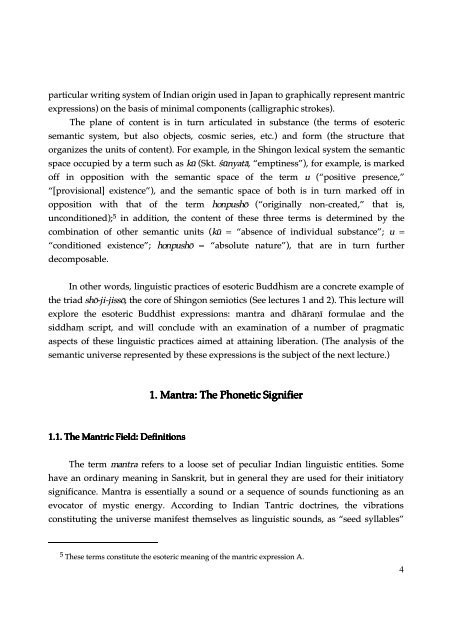
![Shushogi, Dogen Zenji [PDF] - Mahajana.net](https://img.yumpu.com/50921105/1/190x219/shushogi-dogen-zenji-pdf-mahajananet.jpg?quality=85)


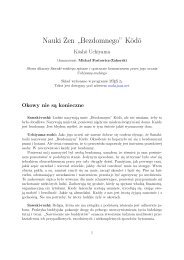

![wywiadu z Murakami Kosho Roshim [PDF] - Buddyzm w Polsce i na ...](https://img.yumpu.com/45809746/1/184x260/wywiadu-z-murakami-kosho-roshim-pdf-buddyzm-w-polsce-i-na-.jpg?quality=85)
